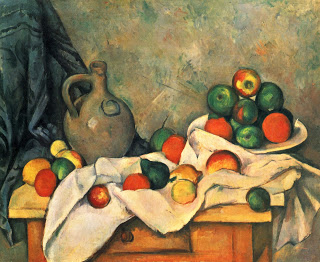Sometimes reading a biography of an artist helps a great deal. I have just finished the superbly detailed Cezanne: a Life by Alex Danchev, and am still absorbing the many lessons about art practices, as lived and learnt during Cezanne's life.
Self Portrait with Rose Background, oil on canvas, Paul Cezanne, c. 1875. Image courtesy of a Private Collection
One of the main lessons I derived from this biography and from other wonderful publications and exhibitions of Cezanne's work is that tenacity needs to be allied with a dogged belief in one's own artistic vision or voice. Despite all his doubts and setbacks, Cezanne kept going back and back to certain subjects - apples, his beloved Mont Sainte-Victoire, self-portraits, etc. Each time, he did something new, something inventive, something better, stronger and more personal.
Curtain, Jug and Fruit, oil on canvas, Paul Cezanne, 1894, Private collection
Another lesson that can be learned is how valuable it is to paint sur le motif as Cezanne called plein air painting. He went out time and time again to work in the sun and heat or difficult conditions - he found new ways to render the landscape. He told young painters, "The main thing in a painting is finding the right distance." But finding the correct distance often meant a great deal of innovation, a break from previous, Renaissance traditions of what was far and what was near. He collapsed distances, he gave us all licence to make horizontals and verticals indistinct one from the other, he showed that colour could serve as "all the ruptures in depth". In essence, he allowed us all to become 20th/21st century artists who can paint in whatever way seems appropriate.
Mont Sainte-Victoire, oil on canvas, Paul Cezanne, 1897. Image courtesy of Baltimore Museum of Art, Baltimore
Another vital lesson is that Cezanne looked and looked so hard at his subject - to find its "truth". He was frantically absorbing all he could about what he was seeing, trying to understand it, trying to grapple with it so that he could mutate it onto his canvas. "Cezanne at his easel, painting, looking at the countryside: he was truly alone in the world, ardent, focused, alert, respectful," as Renoir wrote. Every artist working from life needs to scrutinise the subject as carefully and attentively as possible - then, and only then, can one really hope to transmute it and interpret it according to oneself.
A lesson which resonates with me is Cezanne's passion for trees - pine trees and olive trees in particular. He painted them again and again, depicting them as one would depict a close friend, loved and carefully studied. They were noble examples of Nature, which resonated so deeply with Cezanne. As Ravaisou is quoted as saying in Cezanne a Life, "he was a sensualist in art. He loved nature with a passion, perhaps to the exclusion of all else; he painted in order to prolong within himself the joy of living among the trees." We can all learn from his paintings of the Large Pine and other tree paintings.
Large Pine and Red Earth, oil on canvas, Paul Cezanne (1890-95). Image courtesy of the Hermitage Museum, St. Petersbourg
Pistachio Tree at Chateau Noir, watercolour with graphite on cream wove paper, laid down on tan wove paper, Paul Cezanne. Image courtesy of the Art Institute of Chicago
Paint with passion - that is what, ultimately, Cezanne seems to be telling us with the art, writings and musings that we have all inherited.




